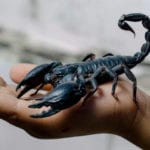 Weird Stuff
Weird Stuff  Weird Stuff
Weird Stuff  Health
Health Ten Confounding New Inventions from the World of Biomedicine
 Creepy
Creepy 10 Death Superstitions That Will Give You the Creeps
 Movies and TV
Movies and TV 10 Movies That Get Elite Jobs Right, According to Experts
 Weird Stuff
Weird Stuff 10 Times Real Laws Were Based on Bizarre Hypotheticals
 Animals
Animals 10 Inspiring Tales of Horses Being Human
 Mysteries
Mysteries Top 10 Haunting Facts About the Ghost Ship MV Alta
 History
History 10 Surprising Stories About the Texas Rangers
 Humans
Humans 10 Philosophers Who Were Driven Mad by Their Own Theories
 Miscellaneous
Miscellaneous 10 Video-Game-Worthy Weapons and Armors from History
 Weird Stuff
Weird Stuff 10 Warning Labels That Exist Because Someone Actually Tried It
 Health
Health Ten Confounding New Inventions from the World of Biomedicine
 Creepy
Creepy 10 Death Superstitions That Will Give You the Creeps
Who's Behind Listverse?

Jamie Frater
Head Editor
Jamie founded Listverse due to an insatiable desire to share fascinating, obscure, and bizarre facts. He has been a guest speaker on numerous national radio and television stations and is a five time published author.
More About Us Movies and TV
Movies and TV 10 Movies That Get Elite Jobs Right, According to Experts
 Weird Stuff
Weird Stuff 10 Times Real Laws Were Based on Bizarre Hypotheticals
 Animals
Animals 10 Inspiring Tales of Horses Being Human
 Mysteries
Mysteries Top 10 Haunting Facts About the Ghost Ship MV Alta
 History
History 10 Surprising Stories About the Texas Rangers
 Humans
Humans 10 Philosophers Who Were Driven Mad by Their Own Theories
 Miscellaneous
Miscellaneous 10 Video-Game-Worthy Weapons and Armors from History
10 Terrifying Creatures of Jewish Folklore
Folkore and traditions can be wild, interesting, exciting, mystifying, and wondrous. But one of the most common ways stories are told is through the terrifying. Humans love to be frightened, and Jewish folklore does not shy away from tales of monsters in the night, the sea, and the forest. Some are even cultural versions of other well-known creatures, such as vampires, genies, and demons (although these demons have their own fun and horrifying twists!).
There are many Jewish demons and mythical creatures very popular in today’s culture, and you will probably recognize at least a few of these, whether from a book or a film. Some you may have never heard of, and perhaps you’ll wish you hadn’t! If you want to learn more, you may have to delve into the depths of Jewish mysticism through Kabbalah or spend years studying Talmudic writings, but hopefully, this list gives you a good start.
Related: 10 Creepy Tales From English Folklore
10 Dybbuks
Dybbuks are creatures of Jewish folklore said to possess individuals, often attributed as the reason behind a person’s mental illness. According to the myth, a dybbuk comes into existence when a person dies with a great number of sins and wanders the earth until it can find a living body to possess.
To remove the dybbuk, a rabbi would need to perform an exorcism alongside ten other men dressed in burial shrouds. Most importantly, the rabbi performing the exorcism would have to make sure the dybbuk was released from between the nail and skin of the big toe so that it didn’t damage the host’s body in any other way upon exiting.
The story of the dybbuk was made popular by a 1916 black-and-white film called Der Dybbuk, a Yiddish-language drama about the creature. More recently, a “dybbuk box” was auctioned on eBay. It consisted of a wine cabinet purported to be the living space of a dybbuk that created nightmares and bad luck for the owner. Kevin Mannis, the person who sold the box, made up a detailed story about its origins that he eventually admitted to being a creative writing experiment.[1]
9 Lilith
Lilith is an increasingly popular Jewish folkloric demon who was supposed to be extremely dangerous for pregnant women and infants, largely due to her origin story. Lilith is thought to be the first wife of Adam, made from clay alongside Adam before Eve was made from Adam’s rib.
According to the story, she disobeyed Adam, uttered the name of God (the forbidden name often represented by the four letters: YHWH), and was expelled from the Garden of Eden. She is mentioned once in the Book of Isaiah and also in the Dead Sea Scrolls. Interestingly, the mention is in a hymn used for exorcisms.
Today, Lilith represents more feminine ideals than the evil baby-murdering sprees of her origins. In her story, she is supposed to have left Adam because he was controlling and dominating over her, and she desired more freedom. She fled to the Red Sea, birthed about a hundred demon babies a day, and vowed to be an enemy of Adam and eventually Eve. But because she broke away from Adam’s control and became a strong female figure of her own, she has come to represent equality, independence, and sexual liberation.[2]
8 Estries (Vampires)
Estries are female vampires who apparently preyed upon Hebrew citizens; the term is from the French strix, which means “night owl.” They were beautiful creatures and attacked indiscriminately. In the Sefer Hasidim, a religious account of Jewish tradition in medieval Germany, Estries are described as having been created on the first Friday but were still incomplete when God rested on the Sabbath. Another account suggests they were created at the Tower of Babel and could fly by anointing their bodies with special oils.
Estries could be restrained by grabbing their hair, forcing them into an oath, or striking them. The only way an estrie could recover from a direct blow was by eating bread and salt belonging to the person attacking them, and they could transform into different bodies to trick someone into giving it over. It isn’t clear how they were ever recognized, but there are multiple accounts of people recognizing an estrie even in their transformed state and killing them successfully.[3]
7 Nephilim
Nephilim are the giants of the world, mainly before Noah’s flood, and descendants of the Watchers (angels sent down from God to deliver messages from God) and humans. They are sometimes described as heroes, but there is a lot of debate around the topic, and they are often described more as “fallen ones.” More accurately, they were descendants of the fallen angels known as Watchers after those supernatural beings reproduced with humans.
Before the flood, the world had fallen into vice and evilness, and the unnatural nephilim are cited as one of the reasons for the flood being necessary. They are not discussed deeply and are only mentioned a few times in the Bible, but they were fearsome giants.[4]
6 The Tigris of the Bei Ilai
In the mythical forest called Bei Ilai supposedly lives a lion (“Tigris”) who is so big there is a space of 9 cubits, or nearly 14 feet (4.3 meters), between its ears. According to the myth, when the Roman emperor Hadrian asked Rabbi Joshua ben Hananiah to show him this insanely large lion, the rabbi tried to warn him against it due to its unusual nature. Hadrian insisted, and from almost 4 miles (6.4 kilometers) away, the lion’s roar was heard.
As a result, all the pregnant women in the area miscarried, and the walls of Rome collapsed. After the lion came another mile closer, he roared, and all the Roman men’s teeth fell out, and the emperor fell from his throne. This is certainly an extremely terrifying lion and not one you would ever wish to encounter! Luckily for Emperor Hadrian, the rabbi was able to pray that the lion go home, and it did.[5]
5 Shedim
Shedim are types of spirits or demons in Jewish folklore, but they are distinctly different from how demons are described in the Christian or Muslim context. They eventually came to be known as a somewhat less negative version of Jinn (you might know them as genies). Shedim are occasionally referred to as “other gods,” or gods who are not the God of Israel and thus inherently evil. They only appear twice in the Bible, but always negatively, as in Deuteronomy 32:17, where it says:
“They sacrificed to devils and not to God: to gods whom they knew not: that were newly come up, whom their fathers worshipped not.”
In this quote, “devils” and “gods whom they knew not” are the shedim, who always appear in the plural. They came to be described more like the Arab Jinn much later on, where comparatively, they can also be killed with iron weapons and are more malevolent, unlike fallen angels from the Christian tradition. Some Kabbalistic rituals involve divining the future through intricate steps, where the shedim are viewed as less evil and more helpful to the person performing the ritual.[6]
4 Golems
No, not Gollum from The Lord of the Rings. Golems are creatures created from clay or other lifeless materials that are intended to serve a troubled community through a difficult time. They are said to only be produced by Jewish mystics well versed in Kabbalah (Jewish mysticism) and are a testament to their skill. In most accounts of golems being created for help, they actually end up causing more trouble than they are worth.
One man, Rabbi Judah Loew of Prague, created a golem to defend the Jewish community of Prague from antisemitic attacks, but after it became violent, it was destroyed. Some say the golem still exists in the attic of the Altneushul in Prague, waiting to be brought back to life when it is eventually needed again.
What kind of violence the golem enacted is unclear, but this act of creation done by a man perhaps mirrors God’s own creation of mankind. Although God may have created the human race, they are free to do good or evil as they please, just as golems created to fix a negative situation can often make those very situations much more severe and terrifying.[7]
3 The Witch of Endor
The Witch of Endor was a witch consulted by the first king of Israel, King Saul. She owned a talisman that could summon the dead, and Saul (in disguise) asked her to use it to obtain the advice of the prophet Samuel, even though Saul himself had outlawed sorcery in Israel. The result of the witch conjuring Samuel was that he successfully predicted Saul’s death the following day but could produce no advice regarding the situation.
Saul and his three sons did indeed die the following day, and Israel fell to the Philistines. Perhaps this isn’t as terrifying as it is ominously horrifying; the witch was able to predict Saul’s fate but not offer any help toward saving him.[8]
2 Agrat bat Mahlat
Agrat was a Talmudic demon who traveled with a hoard of 180,000 destroying angels and was believed to attack on Wednesday and Sabbath nights. It is occasionally believed that Agrat bat Mahlat is another version of the demon Lilith mentioned previously in this list. However, she has her own references in the bible, which are distinct.
This demon is thought to have procreated with a sleeping King David and birthed Asmodeus. She mainly attacks men, especially sleeping men, and is compared to a succubus in many sources. This isn’t an encounter many men would enjoy, however, and there are strong suggestions toward men not to sleep alone on those nights when she is active.[9]
1 Leviathan
The leviathan is a ginormous sea creature that is considered indestructible. Initially, there were two of them, male and female, but God killed the female so that they wouldn’t reproduce and destroy the world. In Olam Ha-ba (the “World to Come”), which is the Jewish belief of life after the messiah comes to Earth, it is believed the leviathan will be served as a meal.
When the leviathan is hungry, it produces heat from its mouth, which will boil the waters around it, and its eyes glow and produce great light even above the water. The only thing which the leviathan fears are worms called “kilbit,” which cling to gills and kill large fish. However, you might struggle to find one of these worms as they are very small. So definitely steer clear of the leviathan.[10]








